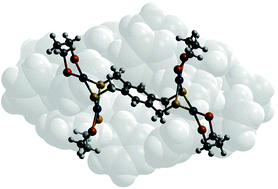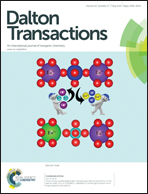Abstract
The silylated organochalcogen reagents 1,2-(Me3SiSCH2)2C6H4, 1a and 1,2-(Me3SiSeCH2)2C6H4, 1b were prepared from the corresponding organobromides and lithium trimethylsilanechalcogenolate Li[ESiMe3] (E = S, Se). They have been characterized by multinuclear NMR spectroscopy (1H, 13C, 77Se) and electrospray ionization mass spectrometry. 1a and 1b react under mild conditions with (1,3-bis(diphenylphosphino)propane)palladium(II) chloride, [PdCl2(dppp)], to provide the dinuclear organochalcogenolate-bridged complexes [(dppp)2Pd2-μ-κ2S-{1,2-(SCH2)2C6H4}]X2, [2a]X2 and [(dppp)2Pd2-μ-κ2Se-{1,2-(SeCH2)2C6H4}]X2, [2b]X2 (X = Cl, Br) in good yield, respectively. Furthermore, the tetranuclear palladium complex [(dppp)4Pd4-μ-κ4S-{1,2,4,5-(SCH2)4C6H2}]X4, [3]X4 (X = Cl, Br) can be synthesized from the reaction of the tetrathiotetrasilane 1,2,4,5-(Me3SiSCH2)4C6H2, and [PdCl2(dppp)]. The structures of [2a]X2, [2b]X2 and [3]X4 were determined by single crystal X-ray diffraction methods. A variety of NMR experiments including two-dimensional homonuclear and heteronuclear correlated spectra were used to probe the solution behaviour of the dinuclear complexes in more detail. These complexes were further characterized by electrospray ionization (ESI) mass spectrometry, and for [2a]X2 and [2b]X2, UV–Vis absorption spectroscopy.


 Please wait while we load your content...
Please wait while we load your content...